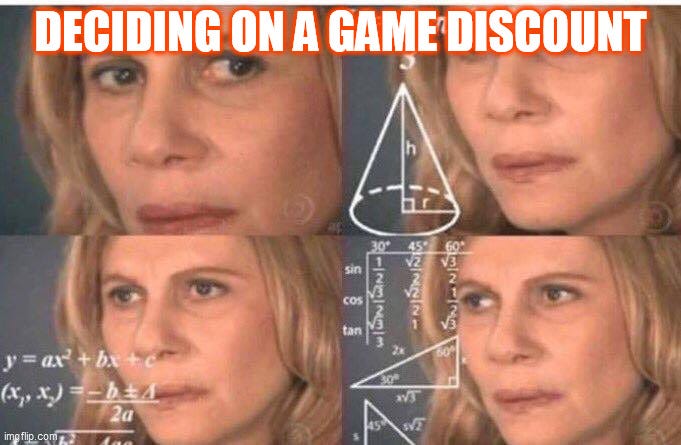
Featured Blog | This community-written post highlights the best of what the game industry has to offer. Read more like it on the Game Developer Blogs.
How much should I discount my game?
I share data on past discounts with Academia : School Simulator in an effort to find the best discount for our version 1 launch.


A perennial question for any game developer is how much they should discount their game during a sale. They must weigh the balance between increasing the number of units sold and possibly devaluing their product and “leaving money on the table”. It’s something that I’ve been thinking about a lot lately as we are about to launch version 1 of Academia : School Simulator. Given that the proper launch of a game is one of the few times Steam gives a real boost to visibility, choosing the wrong discount could make a very big difference in revenue.
30% or 25%?
Initially I was set on doing a 30% discount. We’ve tried to keep Academia’s discounts relatively low to preserve the game’s value, and have used the 30% discount to signal major milestones to the game (Alpha 3, 4. etc). So having a 30% launch discount made sense. But some doubt started to creep in. The 5% difference between 25 and 30 is equivalent to $1 in real money terms. If the amount of units sold at a 25% discount vs a 30% discount is relatively similar, then that means we could be losing $1 per sale that we didn’t really have to. For example, all things being equal, if we sold 10 units at $20 per unit, a 30% discount would net us $140 and a 25% discount would net us $150. 150 is obviously better than 140.
Intuitively, it would seem obvious that a larger discount would drive more sales, and thus net us more revenue. The question is “by how much” and “is it worth it”?
Discount Spreadsheet Explanation
Luckily Academia has been in Early Access for more than 3 years, so I have quite a bit of data to look back on. I prepared this spreadsheet to look at the data since 2019. Here’s a quick explanation of my “methodology”.
Sale type : This provides context on what kind of sale this was.
Visibility Boost : This shows whether I used one of the Visibility boosts steam gives to all developers to allow them to temporarily increase their game’s visibility.
Date: Self explanatory, also helps provide context.
Discount : Amount of discount
Units sold : Units sold in one day of discount
Units sold 1 week before : This is used as a comparison to units sold during the discount. It is assumed that this is a “normal” or control amount of units sold.
Unit difference increase : This is the difference in the number of units sold. This answers the question “how many more multiples of a regular sales day do I get by doing a discount?” I get this number by dividing the discounted units sold by the units sold one week before.
Rounded : just rounds the numbers for easier comprehension.
So for example when I compare the two sales shown above, it says to me that the 30% discount on Alpha 3 gave us 8x more sales than the Lunar New Year 25% discount, which only gave us 2x more sales. Two data points isn’t very useful however, which is why I plotted out many more discounts for comparison.
What does the data show?
So what does the data show? After plotting all the data I took the average increase of sales on dates where we did 30%, 25%, and 20% discounts. Unfortunately we only had two datapoints for the 30% discounts, but lets assume that it’s fairly accurate.
If I am to believe this data then it says that discounting at 30% off generally increases our units sold by 10x, while increasing it by 20%-25% increases our units by 5x. Or put in other words, we double our units sold when discounting at 30% rather than 20%-25%.
In terms of revenue generation, this puts my mind at ease and assures me that 30% is the right number for our launch discount. Even if we assume a more conservative 8x increase vs 10x, the difference is still large enough to cover the “cost” of the additional 10% discount. Taking into consideration the fact that launching verson 1 gives a game a big visibility boost and anecdotal data that Steam’s algorithm is more inclined to share games that make more money, I’m confident this is the right path. However there’s still some lessons to be learned here.
We Left Some Money on the Table
Unfortunately for us, the data seems to have revealed that the past few years of setting discounts at 25% meant that we may have earned us less money than we could have. While there are fewer data points for 20%, the data seems to indicate that there is little difference in units sold between the two of them. That means we lost a dollar ( or about 50 cents, after all deductions) for every sale we made last year by discounting at 25% rather than 20%.
I suspect this is related to psychological pricing, similar to how stores price items as $1.99 instead of $2. The thought in this example is that $1.99 reads more like $1 rather than $2 so the buyer feels like they are getting a better deal.
Conversely, even though 25% is a bigger discount than 20%, when buyers are making a snap judgement based on price, 25% still feels the same as 20%, while 30% feels like an entirely bigger discount because of the change between 2 and 3. So the takeaway here is avoid half measures when it comes to discounting. If you’re deciding between 50% and 40%, just commit to either, don’t do 45%.
Thanks for reading, and hope you found this interesting! If you want to support us, you can buy Academia: School Simulator , Political Animals, or Ruinarch.
Read more about:
Featured BlogsAbout the Author(s)
You May Also Like









